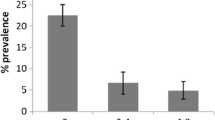Abstract
Isolates of Cryptosporidium parvum obtained from infected humans, calves and lambs were typed using arbitrary primed polymerase chain reaction (AP-PCR) and isoenzyme electrophoresis. All animal isolates tested (n = 17) showed similar profiles in AP-PCR and isoenzyme typing. In AP-PCR assays, 9 out of 15 human isolates showed a distinct “human” profile while the remaining 6 isolates showed the “animal” profile. In isoenzyme typing, 5 human isolates which had shown “human” profiles in AP-PCR demonstrated a unique isoenzyme banding pattern, while 2 isolates which had shown “animal” profiles in AP-PCR gave the “animal” banding pattern. In a murine model of infection, all four animal isolates tested were highly infective but only one of four human isolates identified as “human” type in the AP-PCR and isoenzyme typing systems was infective. The good correlation between the data from the different typing systems supports the hypothesis that there are genetically distinct human and animal populations of C. parvum.
Similar content being viewed by others
Author information
Authors and Affiliations
Additional information
Received: 27 May 1997 / Accepted: 15 September 1997
Rights and permissions
About this article
Cite this article
Awad-El-Kariem, F., Robinson, H., Petry, F. et al. Differentiation between human and animal isolates of Cryptosporidium parvum using molecular and biological markers. Parasitol Res 84, 297–301 (1998). https://doi.org/10.1007/s004360050399
Issue Date:
DOI: https://doi.org/10.1007/s004360050399




